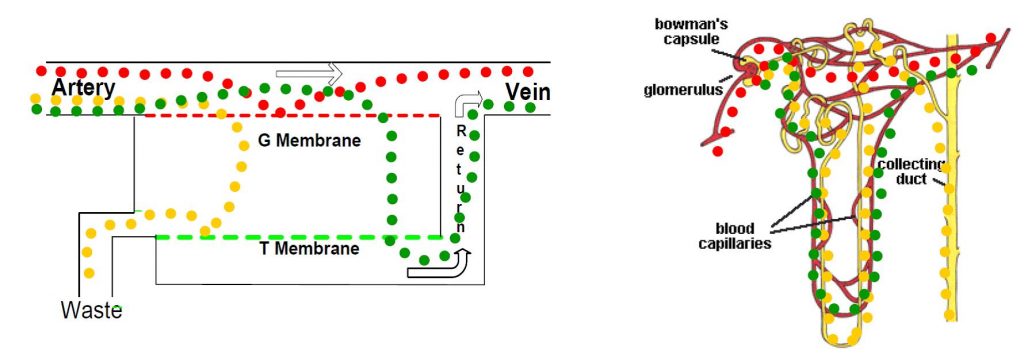MEDICAL
 Covalent technology will be brought to bear against a range of medical challenges both on its own, and in collaboration with other technologies. Applications will include medical diagnostic tools and medical therapeutic devices including artificial organs and drug delivery systems.
Covalent technology will be brought to bear against a range of medical challenges both on its own, and in collaboration with other technologies. Applications will include medical diagnostic tools and medical therapeutic devices including artificial organs and drug delivery systems.
First Challenge: Artificial Organ Mimics the Human Kidney
Of the US population, 17% has Chronic Kidney Disease (CKD) and another 17% is at high risk. That is 34% of the US. Other countries have even higher numbers: Japan, at 23% of the population with CKD, has the highest numbers. Although only a small number of people end up on dialysis or with transplants, tens of millions die prematurely from cardiovascular problems brought on by kidney disease.

The first medical application targets chronic kidney disease and renal failure.
- Worldwide, 10% of the population is affected by chronic kidney disease (CKD), and millions die each year because they do not have access to affordable treatment.
- According the 2010 Global Burden of Disease study, chronic kidney disease was ranked 27th in the list of causes of total number of deaths worldwide in 1990, but rose to 18th in 2010. This degree of movement up the list was second only to that for HIV and AIDs.
Over 2 million people worldwide currently receive treatment with dialysis or a kidney transplant to stay alive, yet this number may only represent 10% of people who actually need treatment to live.
According to the National Kidney Foundation
 Chronic kidney disease is a worldwide health crisis. For example, in the year 2005, there were approximately 58 million deaths worldwide, with 35 million attributed to chronic disease, according to the World Health Organization.
Chronic kidney disease is a worldwide health crisis. For example, in the year 2005, there were approximately 58 million deaths worldwide, with 35 million attributed to chronic disease, according to the World Health Organization.
Our solution, being taken to market by Biophiltre, is a wearable “artificial kidney” whose function is not dialysis, but rather the duplication of essential kidney filtration functions. Like the kidney, the Company’s device (Human Nephron Filter or HNF-1) will separate blood components so that urea and associated toxins can be removed from the blood stream and desirable solutes—red blood cells, albumin, potassium, sodium, calcium, etc.—can be returned to the circulatory system.
Renal Replacement:
The Human Nephron Filter: Toward a Continuously Functioning, Implantable Artificial Nephron System, Blood Purification, Vol. 23, No. 4, 2005. Allen R. Nissenson, Claudio Ronco, Gayle Pergamit, Martin Edelstein, Richard Watts.
Background: Nearly 900,000 patients worldwide have end-stage renal disease and require dialysis or kidney transplantation, and this number is expected to more than double by 2010, placing considerable stress on healthcare systems throughout the world. Despite the availability of these forms of renal replacement therapy for nearly four decades, mortality and morbidity is high and patients often have a poor quality of life. Methods: We have developed a human nephron filter (HNF) utilizing nanotechnology that would eventually make feasible a continuously functioning, implantable artificial kidney. The device consists of two membranes operating in series within one device cartridge. The first membrane mimics the function of the glomerulus, while the second membrane mimics the function of the renal tubules. Findings: The device has been computer-modeled and operating 12 h/day, 7 days/week, the HNF provides the equivalent of 30 ml/min glomerular filtration rate (compared to half that amount for conventional thrice weekly hemodialysis). Conclusions: The HNF system, by eliminating dialysate and utilizing a novel membrane system created through applied nanotechnology may represent a breakthrough in renal replacement therapy based on the functioning of native kidneys. The enhanced solute removal and wearable design should substantially improve patient outcomes and quality of life.
© 2005 S. Karger AG, Basel
Abstract
Nearly 900,000 patients worldwide have end-stage renal disease and require dialysis or kidney transplantation. Despite the availability of these forms of renal replacement therapy for nearly four decades, mortality and morbidity are high and patients often have a poor quality of life. We have developed a human nephron filter (HNF) utilizing nanotechnology that would eventually make feasible a continuously functioning, wearable or implantable artificial kidney. The device consists of two membranes operating in series within one device cartridge. The first membrane mimics the function of the glomerulus, using convective transport to generate a plasma ultrafiltrate containing all solutes approaching the molecular weight of albumin. The second membrane mimics the function of the renal tubules, selectively reclaiming designated solutes to maintain body homeostasis. No dialysis solution is used in this device. The HNF has been computer-modeled, and operating 12 hr per day, 7 days per week the HNF provides the equivalent of 30 mL/min glomerular filtration rate (compared to half that amount for conventional thrice-weekly hemodialysis). Animal studies should begin in the next 1 to 2 years, and clinical trials would then follow 1 to 2 years subsequent. The HNF system, by eliminating dialysate and utilizing a novel membrane system created through applied nanotechnology, represents a breakthrough in renal replacement therapy based on the functioning of native kidneys. The enhanced solute removal and wearable design should substantially improve patient outcomes and quality of life.
Allen R. Nissenson, Innovation in the Treatment of Uremia: Proceedings from the Cleveland Clinic Workshop: Bottom-Up Nanotechnology: The Human Nephron Filter, Seminars in Dialysis, Volume 22, Issue 6, pages 661–664, November/December 2009
Over one million patients worldwide have end-stage renal disease and require dialysis or kidney transplantation. Despite the availability of these forms of renal replacement therapy for nearly four decades, mortality and morbidity are high and patients often have a poor quality of life. We have developed a human nephron filter (HNF) utilizing bottom-up nanotechnology that would eventually make feasible a continuously functioning, wearable or implantable artificial kidney. The device consists of two membranes operating in series within one device cartridge. The first membrane mimics the function of the glomerulus, using convective transport to generate a plasma ultra filtrate, which contains all solutes approaching the molecular weight of albumin. The second membrane mimics the function of the renal tubules, selectively reclaiming designated solutes to maintain body homeostasis. No dialysis solution is used in this device. The HNF has been computer modeled, and operating 12 hour per day, 7 days per week the HNF provides the equivalent of 30 ml/min glomerular filtration rate (compared to half that amount for conventional thrice-weekly hemodialysis). The HNF system, by eliminating dialysate and utilizing a novel membrane system created through applied nanotechnology, represents a breakthrough in renal replacement therapy based on the functioning of native kidneys. The enhanced solute removal and wearable design should substantially improve patient outcomes and quality of life.
Martin Edelstein, Design Paradigms for Monomolecular Membranes aka Implementation of Synthetic Ion Channels, Cleveland Clinic Workshop on Innovation in Uremia Therapy May 14-16, 2008. Invited Lecture
